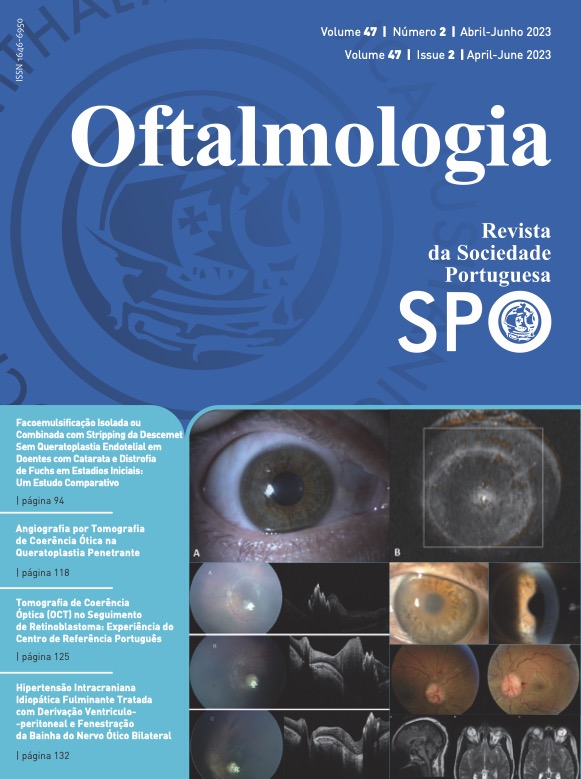Fulminant Idiopathic Intracranial Hypertension Managed with Ventriculoperitoneal Shunting and Bilateral Optic Nerve Sheath Fenestration
DOI:
https://doi.org/10.48560/rspo.28242Keywords:
Decompression, Surgical, Hypertension, Malignant, Intracranial Hypertension/surgery;, Optic Nerve/surgery, Papilledema, Pseudotumor Cerebri, Ventriculoperitoneal ShuntAbstract
Fulminant idiopathic intracranial hypertension (IIH) is a rare form of IIH with rapid and ag- gressive vision loss. Urgent management is required to prevent blindness. We present the case of a 28-year-old woman with new symptoms of transient visual obscurations, headache and pulsatile tinnitus with findings of severe bilateral optic disc edema that developed devastating visual loss. Blood tests, brain imaging and cerebral spinal fluid analysis excluded secondary causes. A lumbar puncture revealed intracranial hypertension and magnetic resonance imaging findings supported it. A ventriculoperitoneal shunt was placed, but due to continued vision deterioration, an urgent bilateral optic nerve sheath fenestration was performed with slight vision improvement. This case highlights the relevance of early recognition of this entity and the demand for prompt considera- tion of surgical management to prevent further visual loss and blindness. It also illustrates the importance of multidisciplinary work and low vision rehabilitation for a young, visually impaired adult.
Downloads
References
Corbett JJ, Savino PJ, Thompson HS, et al. Visual loss in pseudotumor cerebri. Follow-up of 57 patients from five to 41 years and a profile of 14 patients with permanent severe visual loss. Arch Neurol. 1982; 39:461–474.
Wall M, Hart WM Jr, Burde RM. Visual field defects in idiopathic intracranial hypertension (pseudotumor cerebri). Am J Ophthalmol. 1983; 96:654–669.
Lee A, Wall M. Idiopathic intracranial hypertension (pseudotumor cerebri): Epidemiology and pathogenesis. www.uptodate.com/ contents/idiopathic-intracranial-hypertension-pseudotumorcerebri- epidemiology-and-pathogenesis. Accessed October 7, 2022
Lee A, Wall M. Idiopathic intracranial hypertension (pseudotumor cerebri): clinical features and diagnosis. www.uptodate.com/ contents/idiopathic-intracranial-hypertension-pseudotumorcerebri-clinical-features-and-diagnosis. Accessed October 7, 2022.
Jensen R, Radojicic A, Yri H. The diagnosis and management of idiopathic intracranial hypertension and the associated headache. Neurol Sci. 2013;34(suppl 1):S147-S149.
F. Biousse V. Idiopathic intracranial hypertension: diagnosis, monitoring and treatment. Rev Neurol (Paris). 2012;168 (10):673-683.
Smith SV, Friedman DI. The Idiopathic Intracranial Hypertension Treatment Trial: A Review of the Outcomes. Headache. 2017 Sep;57(8):1303-1310. doi: 10.1111/head.13144. Epub 2017 Jul 30. Erratum in: Headache. 2018 Nov;58(10):1697.
Bouffard MA. Fulminant Idiopathic Intracranial Hypertension. Curr Neurol Neurosci Rep. 2020 Mar 26;20(4):8. doi: 10.1007/s11910-020-1026-8.
Thambisetty M, Lavin PJ, Newman NJ, Biousse V. Fulminant idiopathic intracranial hypertension. Neurology. 2007;68:229–32.
Lee A, Wall M. Idiopathic intracranial hypertension (pseudotumor cerebri): prognosis and treatment. www. uptodate.com/contents/idiopathic-intracranial-hypertensionpseudotumor-cerebri-prognosis-and-treatment. Accessed October 7, 2022.
Greenberg M. The Handbook of Neurosurgery. 8th ed. New York, NY: Thieme Publishers; 2016.
Banta JT, Farris BK. Pseudotumor cerebri and optic nerve sheath decompression. Ophthalmology. 2000 Oct;107(10):1907-12. doi: 10.1016/s0161-6420(00)00340-7.
Fonseca PL, Rigamonti D, Miller NR, Subramanian PS. Visual outcomes of surgical intervention for pseudotumour cerebri: optic nerve sheath fenestration versus cerebrospinal fluid diversion. Br J Ophthalmol. 2014 Oct;98(10):1360-3.
Feldon SE. Visual outcomes comparing surgical techniques for management of severe idiopathic intracranial hypertension. Neurosurg Focus. 2007;23(5):E6.
Lai LT, Danesh-Meyer HV, Kaye AH. Visual outcomes and headache following interventions for idiopathic intracranial hypertension. J Clin Neurosci. 2014 Oct;21(10):1670-8.
Kelman SE, Sergott RC, Cioffi GA, Savino PJ, Bosley TM, Elman MJ. Modified optic nerve decompression in patients with functioning lumboperitoneal shunts and progressive visual loss. Ophthalmology. 1991 Sep;98(9):1449-53.
Sergott RC, Savino PJ, Bosley TM. Modified optic nerve sheath decompression provides long-term visual improvement for pseudotumor cerebri. Arch Ophthalmol. 1988 Oct;106(10):1384-90.
van Nispen RM, Virgili G, Hoeben M, Langelaan M, Klevering J, Keunen JE, van Rens GH. Low vision rehabilitation for better quality of life in visually impaired adults. Cochrane Database Syst Rev. 2020 Jan 27;1(1):CD006543.
Downloads
Published
How to Cite
Issue
Section
License
Copyright (c) 2023 Revista Sociedade Portuguesa de Oftalmologia

This work is licensed under a Creative Commons Attribution-NonCommercial 4.0 International License.
Do not forget to download the Authorship responsibility statement/Authorization for Publication and Conflict of Interest.
The article can only be submitted with these two documents.
To obtain the Authorship responsibility statement/Authorization for Publication file, click here.
To obtain the Conflict of Interest file (ICMJE template), click here





